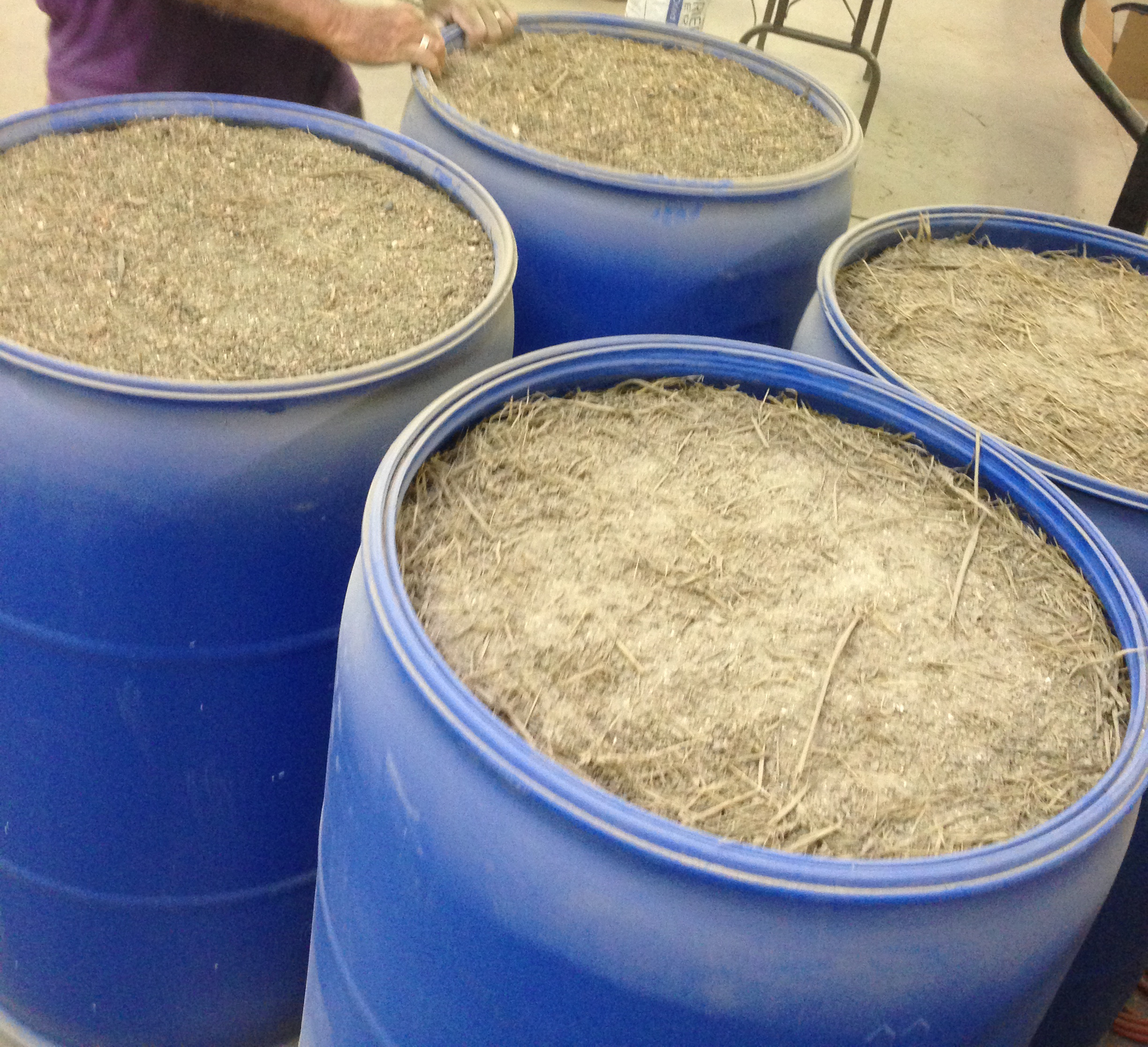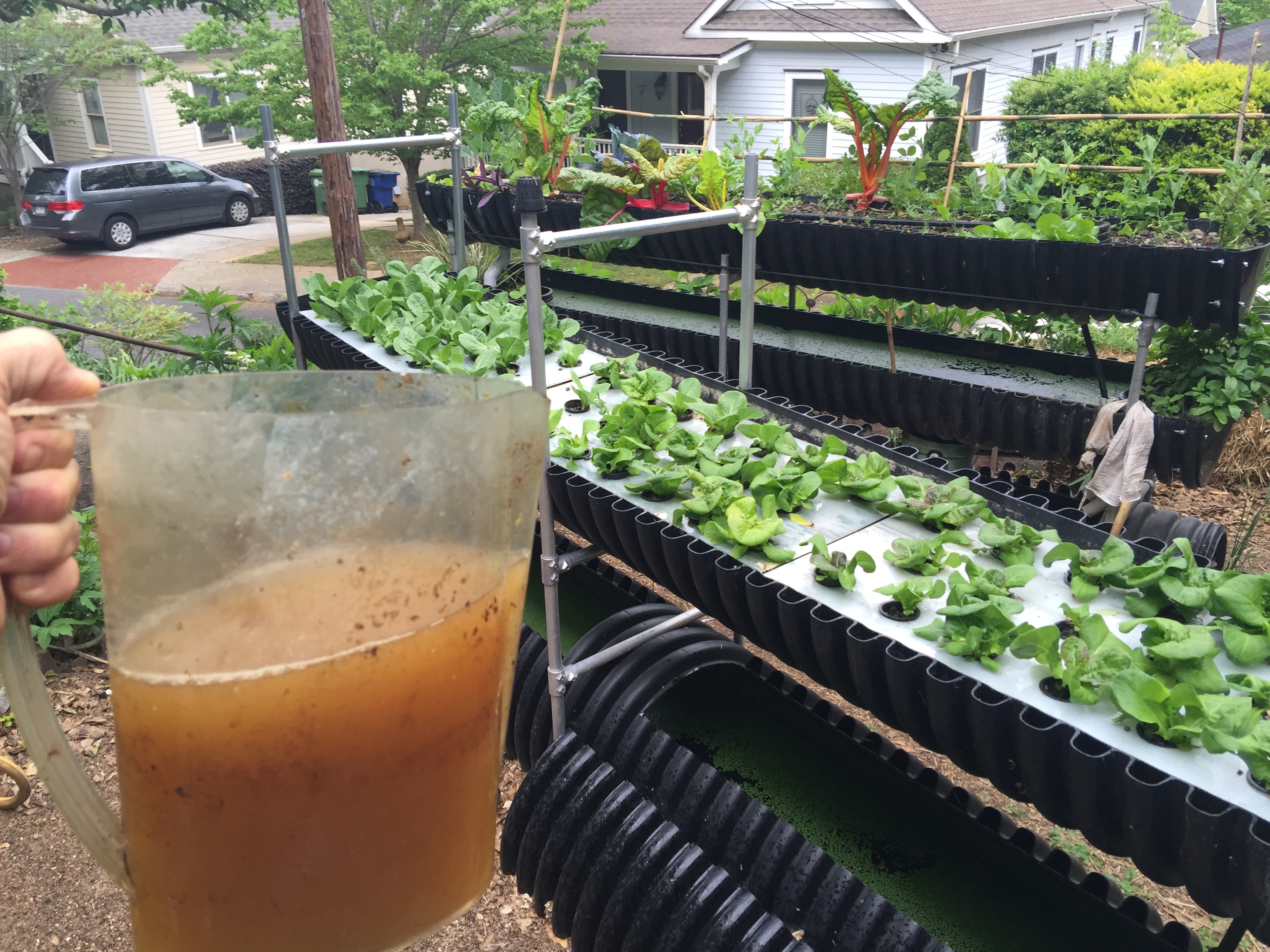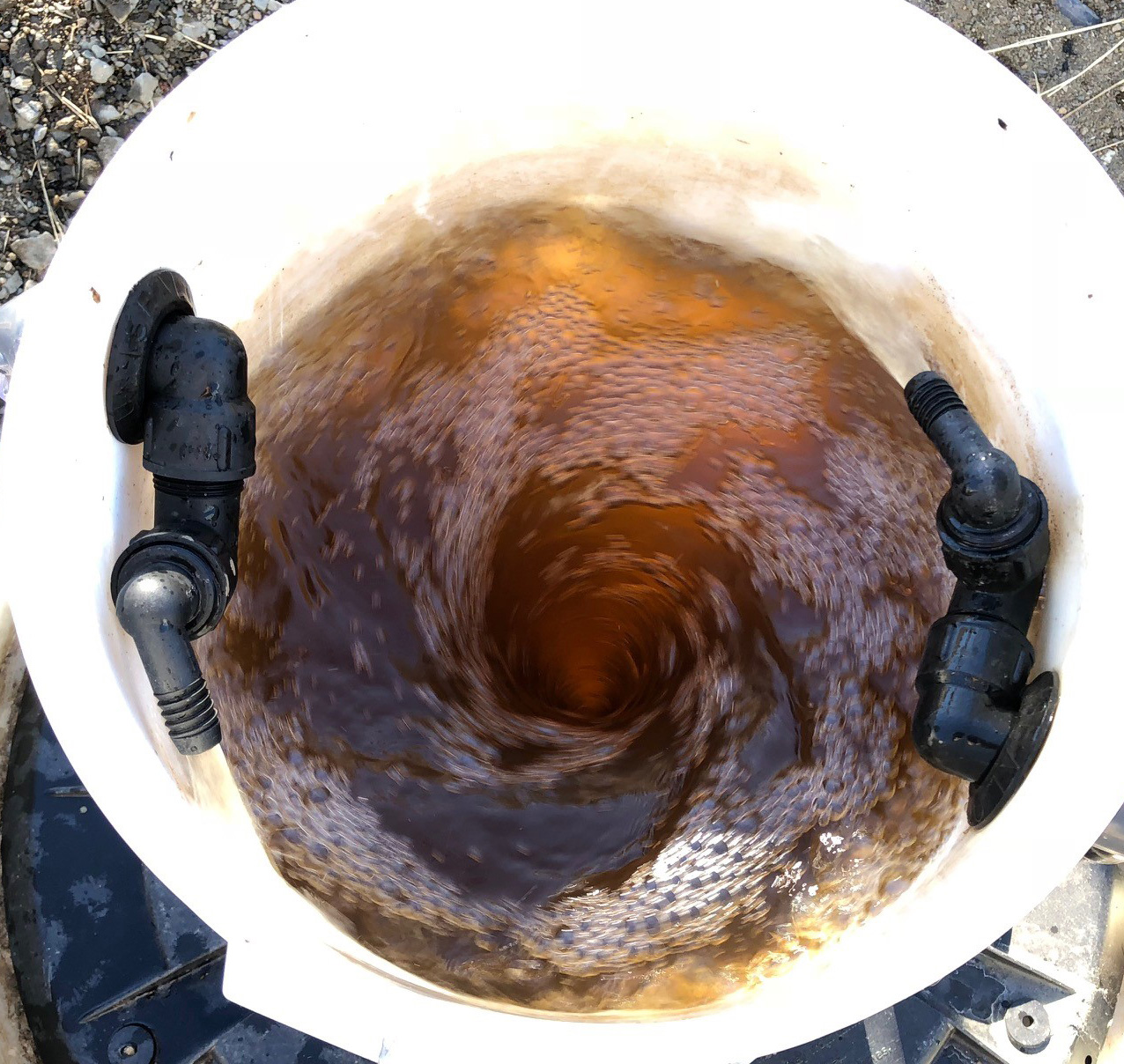The Nutricycler and fertlizer improves farming sustainability by providing nutrients to plants, microbes, fish and worms.
MAKING LIQUID FERTILIZER
Step One: Select Biomass

Biomass is prepared from any number of sources. We prefer to start with dry blends prepared for specific NP and K ratios. Bioponica makes Primordial Soup dry mix blends for this nutricycling process.
Add Biomass to Water Tanks

With dry blends we have found that a good ratio to mix organics to water is 3:1. By loosly closing the lid, any mix of water to high organic matter will naturally become anaerobic.
Monitor pH and Fermentation

Anerobic conditions with develop rapidly and this biomasses solution will quickly go acidic. With a little heat this will decompose into a leachate within 10 day to 3 weeks, depending on the blend formula. This liquid is then ready to be used in a Nutricycler or else used as is, as a soil fertilization or a fish feed.
Nutricycle with Vortex and BIofiltration

The Nutricycler is Bioponica's design for converting the leachate extract into a plant ready/microbe ready liquid fertilizer that is suitable for soilless, media-less deep water culture type grow beds.
The Nutricycler and fertlizer improves farming sustainability by providing nutrients to plants, microbes, fish and worms.
APPLICATION OF LIQUID FERTILIZER AND RECYCLING SOLIDS
Using anaerobic leachate in soil or as fish feed

The carbon rich leachate from decomposed organic matter is highly nutritious and rich in organic (carbon) compounds. Carbon is the fuel for caloric energy production by microbes and other organisms utilizing respiration as a means of metabolism. When added to fish tanks, filter feeders remove the solids and derive their nourishment. When applied to soils, microbes proliferate and a life cycle is perpetuated providing ultimately an inorganic nutrient to the plants (plant ready),.
Using nutricycled liquid in hydroponics

When carbon is removed through biofiltration and vortex aeration, the reduced carbon liquid is converted to a higher nitrate-nitrogen form. It wall also be low enough carbon (similar to inorganic liquid fertilizer) that there won't become an overgrowth of biofilm or bacteria in the soilless growing setup or on the plant roots. This is expecially important in deep water raft culture, Dutch Bucket and NFT systems where there is no additional biofiltration taking place.

Earthworms are an important resource in the process of DIY organic liquid fertilizer production. The complete the process of making use of all inputs but converting sludge from the anaerobic tanks into worm castings.
Bioponica Fertilizer Making
'NPK Fertilizer Brewery outfitted in a shipping container
'Bioponica supplies NPK balanced feedstock for fertilizer Brewery
Grass clippings as ideal source for making liquid fertilizer'
NPK Brewery includes grass silage for storage and fermentation'
Includes vortex water cyclone aeration to mix and oxygenate10' heading='NPK Fertilizer Brewery™ is an organic agriculture facility that converts biomass into organic liquid fertilizer.'
The NPK Brewery™ is a portable facility for making fertilizer using a process called Nutricycling™. It is designed to entirely replace farmers need for mined and petrochemical fertilizers.
The NPK Brewery™ consists of a series of extraction vessels, and processors that receive biomass in one end and convert to a liquid fertilizer, suitable for in-ground farming and organic hydroponics, out the other.
Organic farmers, both soilless and in-ground, have the challenge of competing with conventional inorganic farmers who apply inexpensive chemical fertilizers by spray, fertigationor broadcasting. Organic farmers must either bear the labor of creating and applying the compost, or spend a good deal of money to purchase organic liquid fertilizers. Compost itself, provides a soil ‘amendment’, which has good properties for the soil, but with only modest nutrient concentrations of NPK; it is not rich enough to call a fertilizer.
There are 123 million households in the US producing 80 million tons of food waste and grass clippings per year. The annual use of nitrogen fertilizer for lawn care in the US is a staggering 3 million tons. At a retail price of about $3.50 per pound of nitrogen, the cost to consumers exceeds $21 billion dollars per year. On top of that is the cost remediate the environment as a consequence of the excessive use of fertilizer and unsustainable disposal of waste.
The Nutricycler™ and NPK Brewery™ provide a sustainable agriculture solution for hydroponics and in-ground farms. These systems allow growers to control the amount of dissolved organics in the finished liquid fertilizer.
-
- More-organics fertilizer provides a carbon source for microbes in the soil or in soilless media beds.
- Less-organic extractions are ideal for irrigation and as foliar spray fertilizers.
Soilless growers can use the plant-ready liquid fertilizer in DWC deep water culture systems growing lettuces or basil for example or in NFT nutrient film technique troughs with tomatoes and melons.
Medical marijuana growing operations can use the plant ready liquid fertilizer in setups that employ micro-fine drip ‘ferti-gation’ or drench-irrigation.
'Making liquid fertilizers is a highly sustainable farming practice
Growers can easily make liquid fertilizer by submerging fresh cut grasses, silaged grasses and food waste into water tanks. From there the nutrient extracts and decomposted solids pass through a series of vessels that give us a plant-ready product with high NPK fertilizer numbers. This is a low labor and inexpensive process to maintain:
- All nutrients are trapped in enclosed vessels
- pH conditions are maintained that minimize ammonia and methane loss
- A combination of anaerobic and aerobic fermentation minimizes odors
- Grass and food waste have more nutrients and few pathogens vs using manures to make fertilizer
- By staging liquid extraction processes farmers can create blends from storage vessels containing concentrates of NPK nitrogen, phosphorus and potassium.
- The biomass residue from fertilizer leaching and extraction is a perfect feed stock for earth worms.
- The process of making fertilizer liquids, when using the Nutricycler™ or NPK Brewery™ is fast, on average 2-4 days!
- Because liquid fertilizers can be used as foliar sprays, fertigation or for plant drenching, getting them the plants is effortless.
- No tillage required when using liquid fertilizers.
- Green waste management with no runoff and no atmospheric nutrient loss is good for the environment.
- Processing possible year round and in cold climates as the NPK Fertilizer Brewery™ is primarily an indoor fertilizer facility.
Organic farmers have difficulty competing with inorganic farmers and showing a profit, because the composting methods are typically not sustainable. That's because:
- Making compost is not the same as making fertilizer. Compost has much lower NPK numbers.
- Composting is labor intensive
- Composting loses nutrients such as ammonia and methane to the atmosphere
- Compost piles require moisture but nutrients are leached to the ground or else runoff
- Effective use of composting requires soil tilling, a method that leads to further nutrient degredation and microbial loss.
- Compost piles take months to complete a ready-to-use soil conditioner.
- Spreading compost is also labor intensive!

